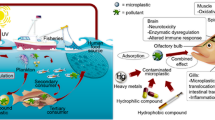Abstract
This study was carried out to generate data pertaining to spatial distribution of PAHs immediately after an oil spill event in a near shore environment. The physico-chemical characteristics of the sea water after the oil spill event indicated pH variation between 7.69 and 8.06, temperature varied between 27.0 and 29.5°C, turbidity ranged from 1.1 to 7.6 NTU and salinity ranged from 17 to 26 mg/L. Highest PAH concentration of 84 ± 3.0 ng/L was recorded for benzo (a) pyrene, followed by fluorine, which was 77 ± 2.0 ng/L. However, the lowest concentration of 7.0 ± 2.0 ng/L was recorded for pyrene. The concentration of PAHs was significantly (p < 0.05) different at different sampling locations. Furthermore, the PAHs with less than three rings were present at all the studied locations, while those with more than four rings were recorded from six or less sampling location. Hence, it may be concluded on the basis of these results that the nature and distribution of PAHs is an important aspect, which needs to be assessed prior to delineating the oil spill management strategy.


Similar content being viewed by others
References
Alvarez Piñeiro M, Lage M, Carril González-Barros S, Lozano J (1996) Aliphatic hydrocarbons levels in turbot and salmon farmed close to the site of Aegean Sea oil spill. Bull Environ Contam Toxicol 57(5):811–815
APHA—American Public Health Association (2005) Standard methods for the examination of water and wastewater, (APHA-AWWA), 21st edn. Washington, DC. Method 6410 B
ATSDR (2005) Toxicology profile for polyaromatic hydrocarbons. ATSDR’s toxicological profiles on CD ROM. CRC Press, Boca Raton
Collins J, Brown J, Alexeeff G, Salmon A (1998) Potency equivalency factors for some polycyclic aromatic hydrocarbons and polycyclic aromatic hydrocarbon derivatives. Regul Toxicol Pharmacol 28(1):45–54
EPA (1995) Toxic criteria for those states not complying with Clean Water Act section 303(c) (2) (B). 40 CFR 131, pp 531–548
EPA (1996) Drinking water regulations and health advisories, EPA-822-B96-002. USEPA, Officer Of Water, Washington
Harvey R (1991) Environmental occurrence and cancer. In: Combs MM, Ashby J, Hicks RM, Baxter H (eds) Polycyclic aromatic hydrocarbons—chemistry and carcinogenicity. Cambridge University Press, Cambridge, pp 11–25
Hellou J, Leonard J, Collier T, Ariese F (2006) Assessing PAH exposure in feral finfish from the Northwest Atlantic. Mar Pollut Bull 52(4):433–441
Hinga K (2003) Degradation rates of low molecular weight PAH correlate with sediment TOC in marine subtidal sediments. Mar Pollut Bull 46(4):466–474
Ke L, Wong TW, Wong Y, Tam NF (2002) Fate of polycyclic aromatic hydrocarbon (PAH) contamination in a mangrove swamp in Hong Kong following an oil spill. Mar Pollut Bull 45(1–12):339–347
Koenig S, Savage C, Kim J (2008) Non-destructive assessment of polycyclic aromatic hydrocarbon (PAH) exposure by fluorimetric analysis of crab urine. Mar Pollut Bull 56(12):2003–2008
National Toxicology Program (NTP) (2005) Report on Carcinogens, 11th edn. Public Health Service, US Department of Health and Human Services, Washington
Peterson C, Rice S, Short J, Esler D, Bodkin J, Ballachey B, Irons D (2003) Long-term ecosystem response to the Exxon Valdez oil spill. Science 302:2082–2086
Ramachandran S, Sweezey M, Hodson P, Boudreau M, Courtenay S, Lee K, King T, Dixon J (2006) Influence of salinity and fish species on PAH uptake from dispersed crude oil. Mar Pollut Bull 52(10):1182–1189
Ünlü S (2007) Comparative analytical data in the source determination of unknown spilled oil in the Haydarpasa Port (Marmara Sea). Bull Environ Contam Toxicol 78(5):363–367
Wang Z, Fingas M (2003) Development of oil hydrocarbon fingerprinting and identification techniques. Mar Pollut Bull 47:423–452
Acknowledgments
We thank Director, NEERI for providing the necessary facilities for carrying out this research work. We also thank Dr. Atul Kulkarni, Director, DataSol Consultancy, Nagpur for his guidance in data analysis and editing of manuscript.
Author information
Authors and Affiliations
Corresponding author
Rights and permissions
About this article
Cite this article
Ladwani, K.D., Ladwani, K.D. & Ramteke, D.S. Assessment of Poly Aromatic Hydrocarbon (PAH) Dispersion in the Near Shore Environment of Mumbai, India After a Large Scale Oil Spill. Bull Environ Contam Toxicol 90, 515–520 (2013). https://doi.org/10.1007/s00128-012-0955-6
Received:
Accepted:
Published:
Issue Date:
DOI: https://doi.org/10.1007/s00128-012-0955-6




